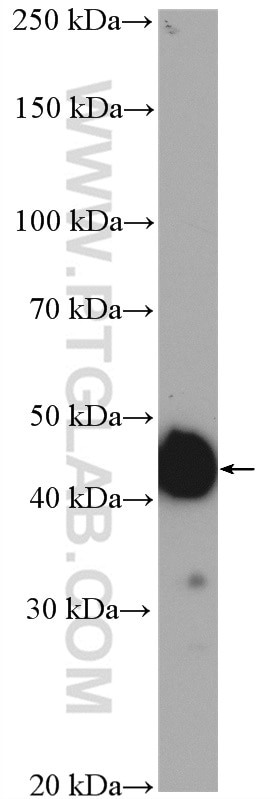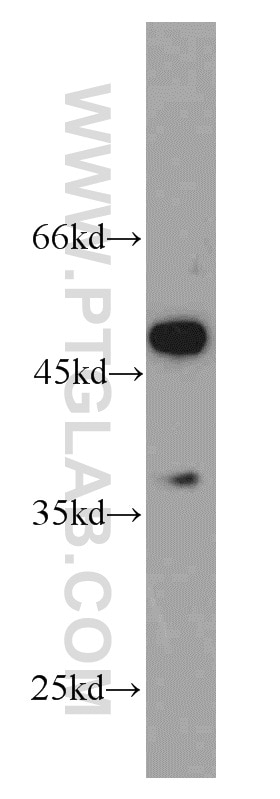- Phare
- Validé par KD/KO
Anticorps Polyclonal de lapin anti-SF3B4
SF3B4 Polyclonal Antibody for WB, IP, IHC, ELISA
Hôte / Isotype
Lapin / IgG
Réactivité testée
Humain et plus (2)
Applications
WB, IP, IF, IHC, ELISA
Conjugaison
Non conjugué
N° de cat : 10482-1-AP
Synonymes
Galerie de données de validation
Applications testées
| Résultats positifs en WB | cellules HEK-293T, cellules HEK-293, cellules PC-3 |
| Résultats positifs en IP | cellules HeLa |
| Résultats positifs en IHC | tissu de cancer du pancréas humain il est suggéré de démasquer l'antigène avec un tampon de TE buffer pH 9.0; (*) À défaut, 'le démasquage de l'antigène peut être 'effectué avec un tampon citrate pH 6,0. |
Dilution recommandée
| Application | Dilution |
|---|---|
| Western Blot (WB) | WB : 1:2000-1:16000 |
| Immunoprécipitation (IP) | IP : 0.5-4.0 ug for 1.0-3.0 mg of total protein lysate |
| Immunohistochimie (IHC) | IHC : 1:20-1:200 |
| It is recommended that this reagent should be titrated in each testing system to obtain optimal results. | |
| Sample-dependent, check data in validation data gallery | |
Applications publiées
| KD/KO | See 3 publications below |
| WB | See 11 publications below |
| IHC | See 4 publications below |
| IF | See 1 publications below |
| IP | See 1 publications below |
Informations sur le produit
10482-1-AP cible SF3B4 dans les applications de WB, IP, IF, IHC, ELISA et montre une réactivité avec des échantillons Humain
| Réactivité | Humain |
| Réactivité citée | rat, Humain, souris |
| Hôte / Isotype | Lapin / IgG |
| Clonalité | Polyclonal |
| Type | Anticorps |
| Immunogène | SF3B4 Protéine recombinante Ag0737 |
| Nom complet | splicing factor 3b, subunit 4, 49kDa |
| Masse moléculaire calculée | 44 aa, 3 kDa |
| Poids moléculaire observé | 50 kDa |
| Numéro d’acquisition GenBank | BC004273 |
| Symbole du gène | SF3B4 |
| Identification du gène (NCBI) | 10262 |
| Conjugaison | Non conjugué |
| Forme | Liquide |
| Méthode de purification | Purification par affinité contre l'antigène |
| Tampon de stockage | PBS avec azoture de sodium à 0,02 % et glycérol à 50 % pH 7,3 |
| Conditions de stockage | Stocker à -20°C. Stable pendant un an après l'expédition. L'aliquotage n'est pas nécessaire pour le stockage à -20oC Les 20ul contiennent 0,1% de BSA. |
Informations générales
SF3B4, also named as Pre-mRNA-splicing factor SF3b 49 kDa subunit, is a 424 amino acid protein, which belongs to the SF3B4 family. SF3B4 is a subunit of the splicing factor SF3B required for 'A' complex assembly formed by the stable binding of U2 snRNP to the branchpoint sequence (BPS) in pre-mRNA. SF3B4 has been found in complex 'B' and 'C' as well. Belongs also to the minor U12-dependent spliceosome, which is involved in the splicing of rare class of nuclear pre-mRNA intron. The calculated molecular weight of SF3B4 is 44 kDa. Based on its predicted molecular mass and the observed migration of the 50kDa cross-linked species on two-dimensional gels.(PMID: 9614130)
Protocole
| Product Specific Protocols | |
|---|---|
| WB protocol for SF3B4 antibody 10482-1-AP | Download protocol |
| IHC protocol for SF3B4 antibody 10482-1-AP | Download protocol |
| IP protocol for SF3B4 antibody 10482-1-AP | Download protocol |
| Standard Protocols | |
|---|---|
| Click here to view our Standard Protocols |
Publications
| Species | Application | Title |
|---|---|---|
Clin Transl Med LncRNA BC promotes lung adenocarcinoma progression by modulating IMPAD1 alternative splicing | ||
Cell Chem Biol Novel RNA-Affinity Proteogenomics Dissects Tumor Heterogeneity for Revealing Personalized Markers in Precision Prognosis of Cancer. | ||
iScience Multi-omics approach reveals posttranscriptionally regulated genes are essential for human pluripotent stem cells. | ||
J Mol Cell Cardiol Remodeling of the m6A landscape in the heart reveals few conserved post-transcriptional events underlying cardiomyocyte hypertrophy. | ||
Cell Death Dis SF3B4 promotes ovarian cancer progression by regulating alternative splicing of RAD52.
| ||
bioRxiv Sf3b4 mutation in Xenopus tropicalis causes RNA splicing defects followed by massive gene dysregulation that disrupt cranial neural crest development |







